
|   |

|   |
Indradhanush Mahotsava and Natyakalavardhini of FAS, Mumbai - Chandra Anand e-mail: chandra6267@yahoo.co.in February 19, 2025 Fine Arts Society had organized its annual festival of cultural activities Indradhanush Mahotsav 2025 from 26th January to 2nd February 2025, at the Sivaswamy Auditorium, Chembur, Mumbai. The festival opened with a dynamic Bharatanatyam presentation of Sridevi Nrithyalaya’s Bharatanatyam group led by Dr. Sheela Unnikrishnan. They presented a thematic production "Madhavam Mahadevam", an invocative theme, delineating popular stories on Lord Shiva and Lord Krishna, describing their omnipresent and omnipotent qualities. The presentation commenced with a prayer in Sanskrit in praise of Sharada Devi. An innovative Alarippu that followed, was set to chaapu maalika talam, a confluence of the tisra, kanda, misra and sankeerna chapu talams, composed by the mridanga vidhwan Guru Bharadwaj. The three speed rhythmic cycles of Alarippu were executed in varying formations with great symmetry and coordination by Harinie, Bhairavi, Mridula, Mrinalini and Kameshweri. As can be expected, even if the audience had found it difficult in keeping pace with the changing jaati or gati, the visually appealing formations and the symmetrical sculpting of the stage captured its attention. 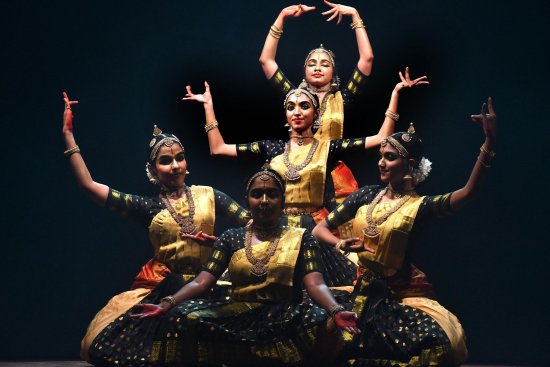 Varnam The second piece was the varnam "Swami naan undan adimai" penned by Papanasam Sivan (Nattakurinji, adi) eulogizing Lord Shiva bestowing his divine grace on Markandeya and Nandanar. Though the cholkattus had the ending with rhythmic syllables of the teermanam thrice, the movements were varied for all three renderings. While the Markandeya Abhayam was shown with lyrics of the pallavi, the Nandanar story was performed to cholkattu (of the jathi) recited before the fourth sahityam. In the uttarangam, the ardis were different for each korvai. They stood like frescoes after every korvai and sahityam. The last sculpturesque pose showed Shiva in the center, in a meditative stance, and others held different icons of Shiva in their hands. These were all visually appealing to all. Thus, the visual senses of the spectators were kept very active till the end. Harinie, Bhairavi, Mridula, Mrinalini and Kameshweri performed this item with great verve and grace. 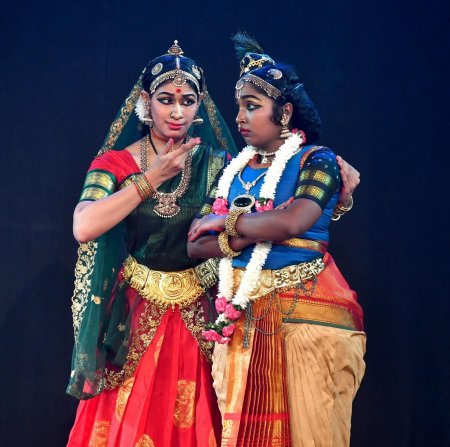 Thaye Yashoda Oothukkadu krithi, "Thaaye Yashoda" (Ragamaalika, adi) which is a delightful dialogue in verse form was choreographed by Shobha Korambil. Here was a move from usual rendering of Gopi complaining to Yashoda. The verses where Krishna refutes the Gopi's complaints were also added. The costumes were apt. As the abhinaya matched the lyrics, the dramatic gestures applied to the abhinaya aligned with music. Dramatic impact was well sustained throughout the rendering of the item. A mischievous Krishna (Bhairavi), the harassed Gopi (Mridula) and mother Yashoda (Sanjena) stuck between them, regaled the audience with their portrayals. 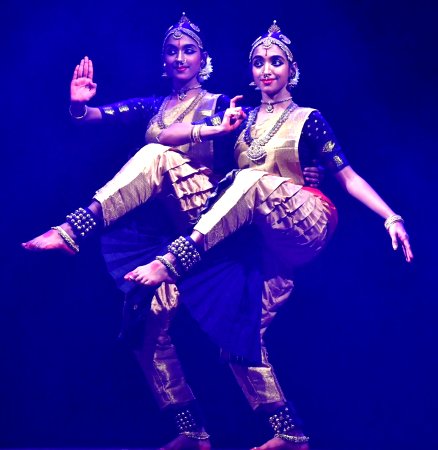 Mrinalini & Mridula A kirtanam on Lord Nataraja, "Neeyada naa aduven" (Kamas, adi) is a composition of Guru Mangudi Durairaja Iyer and was choreographed by Sheela Unnikrishnan. This piece celebrates Nataraja, the cosmic god of dance, by describing his omnipresent qualities and the effect of dance on all beings. As he dances, everyone dances with him and also feel they merge within him. This choreography delineated a lot of nritta. The adavus to cholkattus were done alternately by the dancers and ended with different poses of Shiva. After performing complex korvai to swara patterns they stood in varied 'Shiva Parvati' poses. All of these brought out the musicality and picturesque quality of the art of dance. This item was performed by Mridula and Mrinalini. 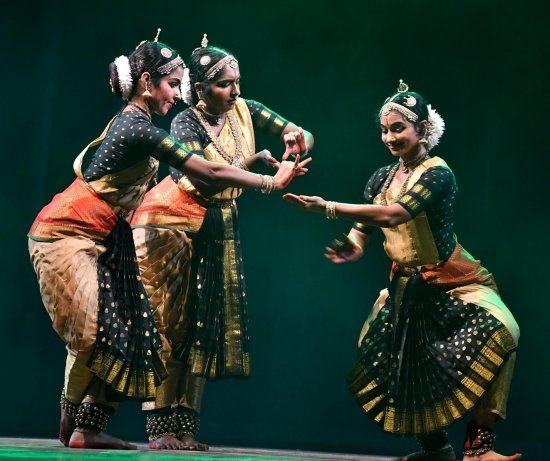 Vamana avataram The theme then progressed to a special performance with the ashtapadi of Jayadeva from Gita Govinda where the verses describing the ten incarnations of Mahavishnu, Krishna according to Jayadeva, taken for the benefit of mankind were performed in a special manner. Along with delineating the omnipotent virtue of the lord through Dashavatara, (Ragamalika, adi) the dancers also combined painting a picture in black paint, of the Lord, depicting the ten avataras in his form, between the interludes of each avatara. There was thrill in watching the painting made beautifully by all the performers taking turns. This grand finale was conceived and conceptualized by Sheela Unnikrishnan and set to music by Srikanth Gopalakrishnan. The artists dancing and painting were Harinie, Bhairavi, Mridula, Mrinalini and Kameshweri. This outstanding Bharatanatyam performance by the Sridevi Nrityalaya dance group known for its harmony, coordination and synchronization definitely enthralled all and a befitting start to the Mahotsava. Concept and choreography were by Sheela Unnikrishnan and they performed to recorded music. The performers were Harinie Jeevitha, Bhairavi Venkatesan, Mridula Sivakumar, Mrinalini Sivakumar, Kameshweri Ganesan and Sanjena Ramesh. Impressive abhinaya by Apeksha Niranjan The Fine Arts Society, Chembur, Mumbai, has been promoting cultural excellence for over six decades, in their Natyakalavardhini series that encourages upcoming dancers. On 10th January 2025, at FAS RCF Academy Hall, Bharatanatyam was presented by Apeksha Niranjan, a disciple of Gurus Sucheta Chapekar and Alka Lajmi. Apeksha presented items from the Bharatanatyam margam repertoire. She began with Ganga stuti,"Bhagirathi Bhavadveshini" (Darbari, chatushra ekam) which is a composition describing the greatness of the sacred River Ganga and exposing of Sage Bagirathi's efforts to bring her to the earth to make this land holy. This was choreographed by Apeksha Niranjan and presented in a promising manner. Krishna Kautukam, "Mi Krishna pahila" in Marathi, composed and choreographed by Sucheta Chapekar followed. The poem describes the joy of Gopi to see Krishna and experience his omnipresence. The Gopi finds him everywhere and describes his human as well as his omnipotent qualities. Krishna as a son, a beloved and mischief maker and as a savior of the world was done in a cheerful manner bringing out myriad sentiments towards the Lord. 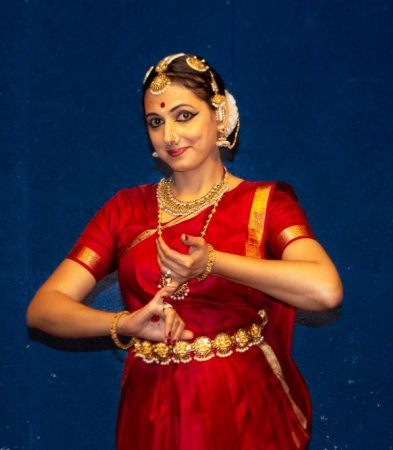 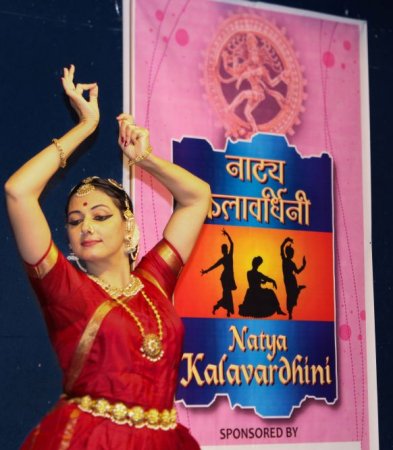 Apeksha Niranjan The varnam was presented with the verse "Shive Srungaradhya" (Ragamalika, adi) from the Soundarya Lahari of Adi Shankaracharya. The music for this piece was composed by Smita Mahajan, jathis were composed and recited by KN Venkatesh and choreography was by Apeksha Niranjan. Here she described the glory of Goddess Parvati through the navarasa as expressed in the shloka. The traditional varnam structure was well formatted in spite of being a single verse. Jathis and korvais were well choreographed ending with appropriate ardhis. The rasa bedhas were clearly delineated with appropriate instances. "Yarukkagilum bhayama" (Begada, mishra chapu), a padam composed by Subbarama Iyer and choreographed by Bragha Bessel, followed. She brought out the padartha bhava easily. In the vatsalya bhavam padam "Kuzhanday Ganapathiye" (Hindolam, adi), composed by K. A. Sivaramakrishnan from Mumbai, she explored the story of the competition to win the mango between Ganapathi and Karthikeya. Here, creative license has been applied to inculcate the act of sacrifice. Parvati convinces Ganapathy to give the fruit to his younger brother, as offering one's favorite thing to someone is deemed as sacrifice. While compering Apeksha enunciated clear Tamil diction which was well appreciated by the Tamil spectators in the audience. Her portrayals of all the characters came through very well and abhinaya skills reached out to one and all. Thillana (Kalyani, tisra gati), in Marathi language, "Tat dhin nam karu nartan, tak dhin nam man darpan, Talanishi kari Narthan, Nayan he tuze", composed by Smita Mahajan and choreographed by Apeksha Niranjan, was performed with aplomb. This Thillana describes beautiful eyes of the dancers. It eulogized that, through 'You' (eyes) the dancer portrays various characters like Kamakshi, Meenakshi, Kamalakshi, Mruganayani. Finally, an Abhang penned by Saint Eknath, "Maze Maher Pandhari" (Mohanam, chatusra ekam) and choreographed by Apeksha Niranjan was performed, creating another round of devotional ambience. Here her sanchari depicted had good credibility. Apeksha showed prowess and a great passion for Bharatanatyam.  Chandra Anand is a Bharatanatyam artiste and teacher. She has an MA in Bharatanatyam from Tilak Maharashtra Vidyapeeth, and her series on 'Education in spiritual values through Bharatanatyam' is featured in narthaki.com. |